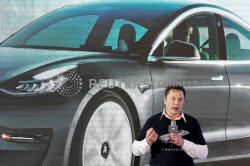Tesla's rise made 2020 the year the U.S. auto industry went electric
 Send a link to a friend
Send a link to a friend
 [December 21, 2020] By
Joseph White [December 21, 2020] By
Joseph White
DETROIT (Reuters) - Tesla Inc and Wall
Street made 2020 the year that the U.S. auto industry decided to go
electric.
Tesla's market capitalization surged above $600 billion, making the once
wobbly startup founded by billionaire Elon Musk worth more than the five
top-selling global vehicle making groups combined. The exclamation point
came on Friday when Tesla rose to a record high in frantic trading ahead
of the stock's much anticipated entrance into the benchmark S&P 500
index..
For 2021, all signs point toward the industry accelerating its shift
toward electrification, a turning point as historically momentous as the
launch of Ford Motor Co's moving assembly line for the Model T or
General Motors ' 2009 bankruptcy.
Tesla's ascent came the same year that activist hedge funds and other
investors ratcheted up pressure on corporations to fight climate change.
Evidence is growing that more investors have concluded the century-long
dominance of internal combustion engines - "ICE" in industry slang - is
headed toward a close within a decade.

From London to Beijing to California, political leaders also embraced
plans to start phasing out internal combustion engine-only vehicles as
early as 2030. Pressure to cut greenhouse gas emissions undermines the
logic for significant new investments in ICE engines. Thousands of
manufacturing jobs are currently tied to internal combustion in the
United States, Britain, Germany, France, Japan and other countries.
Other powerful forces also shook the auto industry's status quo this
year. The COVID-19 pandemic stripped away the sales and profits that
incumbent automakers had counted on to fund methodical transitions to
electric vehicles. China's rapid recovery from the pandemic exerted an
even more powerful gravitational pull on industry investment.
WILL CONSUMERS PLUG IN?
This was the year GM Chief Executive Mary Barra and other top industry
executives began to echo Tesla's Musk, saying electric vehicle battery
costs could soon achieve parity with internal combustion technology.
Still, it remained to be seen whether consumers, particularly in the
United States, are ready to say goodbye to petroleum-fueled pickup
trucks and SUVs.
The best-selling vehicles in the United States remain large,
petroleum-burning pickup trucks. Demand for these vehicles powered a
recovery for Detroit automakers after the pandemic forced factories to
shut down in the spring.
The best electric vehicle and battery makers could field models that
match internal combustion upfront cost as soon as 2023, brokerage
Bernstein wrote in a report.
"ICE game over with BEV ~ 2030," Bernstein's auto analysts wrote, using
the industry's acronyms for internal combustion engine and Battery
Electric Vehicle.
The shift toward electric vehicles is speeding a parallel transformation
of vehicles into largely digital machines that get much of their value
from software that powers rich visual displays and features such as
automated driving systems.
[to top of second column] |

Tesla Inc CEO Elon Musk
speaks onstage during a delivery event for Tesla China-made Model 3
cars at its factory in Shanghai, China January 7, 2020. REUTERS/Aly
Song/File Photo

Across the industry, century-old manufacturers such as Daimler AG are scrambling
to hire programmers and artificial intelligence experts.
The capability of software to manage autonomous driving systems, electricity
flows from batteries and data streaming to and from vehicles is replacing
horsepower as a measure of automotive engineering achievement.
Tesla's use of smartphone-style over-the-air software upgrades was once a unique
feature of the Silicon Valley brand. In 2020, the best-selling model line in the
United States, the Ford F-150 pickup, was redesigned to offer over-the-air
software updates, making the technology as mainstream as it gets.
THE PANDEMIC AND CHINA
In the best of times, traditional internal-combustion vehicles would have faced
huge costs and disruptions to their workforces to evolve to electric,
software-intensive vehicles. But the shock delivered by the coronavirus pandemic
gave manufacturers much less money and time to adapt.
Consultancy IHS Markit forecasts that global vehicle production will not match
2019 levels again until 2023. Automakers will have produced 20 million fewer
vehicles by 2023 than they could have built had output stayed at 2019 levels.
“Only the most agile with a Darwinian spirit will survive,” said Carlos Tavares,
the Peugeot SA chief who will lead the combined Peugeot and Fiat Chrysler when
that merger is completed.
The pandemic also elevated the importance of China to the industry's future.
That country's swift recovery from the pandemic amplified the gravitational pull
of its huge market on automotive investment, despite anti-China rhetoric from
U.S. and European politicians.

China's drive to reduce dependence on petroleum is compelling automakers to
shift investment toward battery electric and hybrid vehicles, and re-center
design and engineering activities to Chinese cities from traditional hubs in
Nagoya, Wolfsburg and Detroit. Tesla said it will establish a design and
research center in China.
Daimler AG Chief Executive Ola Kaellenius put it bluntly in October: “We need to
look at our production footprint and where it makes sense, shift our
production,” he said during a video call. “Last year we sold around 700,000
passenger cars in China. The next biggest market is the U.S. with between
320,000 and 330,000 cars.”
(Reporting By Joe White; Editing by David Gregorio)
[© 2020 Thomson Reuters. All rights
reserved.] Copyright 2020 Reuters. All rights reserved. This material may not be published,
broadcast, rewritten or redistributed.
Thompson Reuters is solely responsible for this content. |